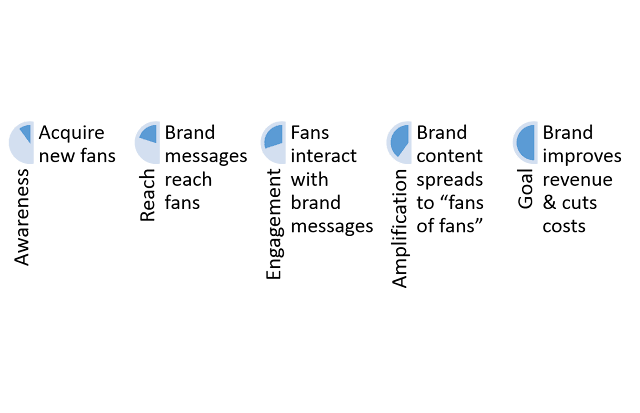
Right before Facebook’s infamous IPO last year, auto company GM made headlines announcing they were going to cut their $10 million paid advertising budget because of “poor performance”.
Part of the reason cited is GM’s product. And part of the reason is also Facebook’s advertising options.
However there’s another, underlying root cause as well…
A common problem that plagues all brands — both big and small — and undermines their promotional strategies.
Here’s the simple, yet little known reason, and how you can fix it.
Why Being Overly Tactical is a Mistake
Today we’re going to tie the entire Facebook marketing series together. And we’re gong to do that by looking at Facebook marketing 30,000 feet.
Because when you’re overly tactical, things fall through the cracks.
Maybe you’re great at getting more fans, but then there’s no interaction. Or maybe you’re great at improving engagement, but you can’t get enough fans to drive any significant revenue.
But when you back up a little bit and put everything in context, then your strategy takes shape and the path begins to reveal itself.
And it’s helpful to begin by discussing how social media marketing should ideally work…
Social Media Marketing 101: Combining Earned, Owned & Paid Media
Every successful social campaign or strategy actually has three major “media” components:
- Earned: Customer-driven word of mouth promotion.
- Owned: Brand controlled — like your blog, or content on Facebook.
- Paid: Brand pays for “access” to channel and/or audience.
Everyone can do at least one of these well. But it’s difficult to get them all working together. With large brands, it’s difficult because there are so many stakeholders and different people involved that you coordination and execution breaks down. With small brands, it’s difficult because you have limited resources and typically only have enough time, money or expertise to implement 1 or 2 out of 3.
But in an ideal world, you get the best results by these three components and using them together. For example, consider these results reported by Marketing Land:
- In the four weeks after seeing Starbucks earned media messages on Facebook, fans of Starbucks and their friends overall bought at Starbucks 38% more frequently.
- Amazon Facebook Fans spent more than twice as much at Amazon as the average Internet user
- In the four weeks after seeing an ad on Facebook from a major offline US-based retailer, fans and their friends bought 56% more frequently online from this retailer.
There are a couple things to notice here…
First, most of the heavy social advertisers fall in under the “transactional sales process” we discussed in the “Facebook Revenue” article.
And secondly, Facebook (and social) ads are not driving customers directly. They’re driving micro-conversions, improving the overall macro-conversion rate and increasing repeat purchases indirectly.
Social advertising and marketing can improve sales… just not in the same way as SEO or Google AdWords.
How Your Facebook Marketing Strategy Should Work
In Part 1 of this series, we discussed how to assign marketing or promotional tactics to different stages of the customer lifecycle.
Let’s circle back to that so we can create a cohesive, integrated Facebook marketing strategy that will drive business goals. Here’s a quick overview of how it should work…
- Acquire new fans through advertising, partnerships, cross-promotions, virality, etc. etc.
- Brand messages reach new fans (on news feed, and through direct tagging or shares)
- Fans interact or “talk about” brand content
- Brand content spreads “virally” to friends of fans
- Achieve marketing goal (Reach, Awareness, Support and/or Revenue)
And here’s how it looks with my nice, pretty graphic for the visual learners out there:

So in an ideal world, the little day-to-day tactics you’re working on, and the larger promotions or campaigns you might be doing should address one (or all) of these stages.
There’s no single, “correct” answer here. There’s more than one way to skin a cat.
One tactic might work well for one brand, and bomb for another. And the truth is that no one (myself included) can predict the future — you just have to start trying, experimenting, failing on a small scale, and iterating to learn what works and what doesn’t.
But it should be extremely easy to identify how each day-to-day tactic aligns with your strategy. And it should be extremely easy to see which areas you’re excelling in, and which ones need more time, money, or manpower behind them.
Getting the tactics right are good. But they’re interchangeable. And individually on their own… not very effective.
However things start to happen when you put them together. Integration trumps isolation.
Driving new revenue — repeatedly — is a multi-step process. And missing one piece of that chain reduces your effectiveness — exponentially.
Discover How to Improve Your Facebook Marketing…
The Facebook Marketing Bootcamp that will show exactly how to get more Facebook fans, increase engagement, and start generating revenue.
I’ll show you the step-by-step process used with my client to grow their Facebook page over 350% — without advertising — and create a new revenue stream for the company that generated 5-figures within 60 days of launch.
Check it out now and get:
- Complete Access to Future Updates
- Future Session #4: Facebook Advertising (Coming November 1st)
- Limited Time Discounted Pricing (Increasing to $197 on October 31st)
- Video Recordings: Can’t make it? No problem! Each session will be recorded and you’ll have forever access
- Cheetsheets & Handouts: Get specific, actionable plans that walk you through each strategy and tactic
- 100% RISK FREE: If you’re unsatisfied for any reason within 30 days, then I’ll give you a complete refund — no questions asked


